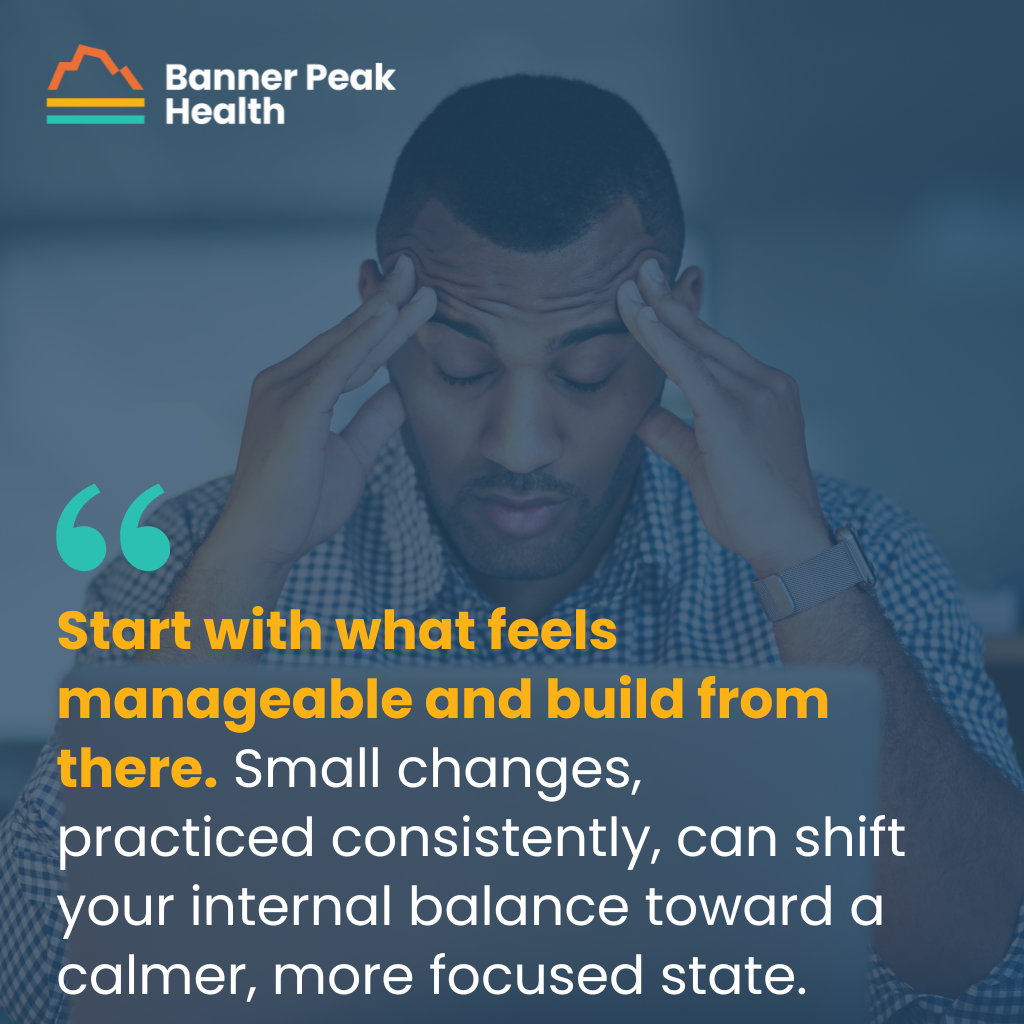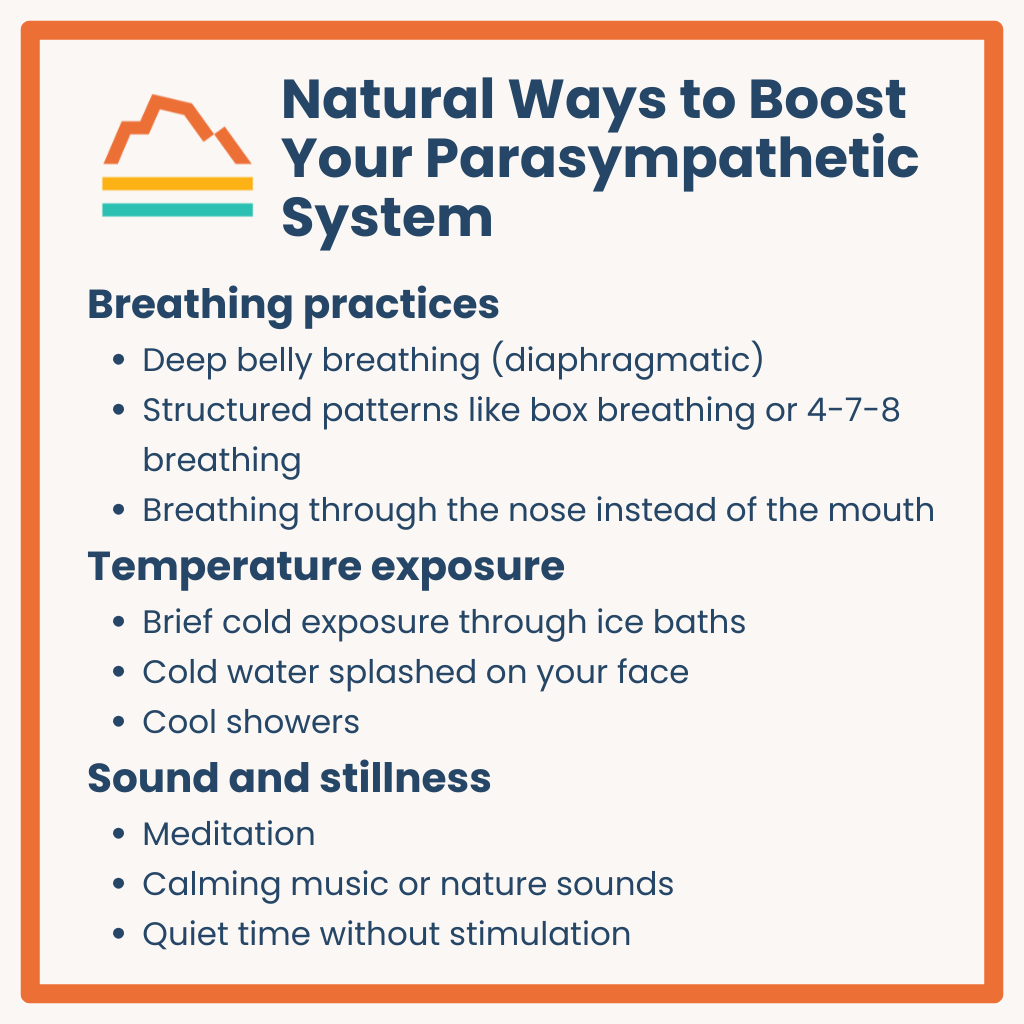I’ve written extensively about stress and its health effects. I’ve focused mostly on reducing stress exposure, but equally valuable is strengthening our body’s intrinsic stress-fighting ability.
This happens through the parasympathetic branch of our autonomic nervous system.
The Balance Within
Our autonomic nervous system (ANS) controls unconscious functions like digestion, breathing, heart rate, and immune response. Two ANS branches work together to maintain balance: the sympathetic (“fight or flight”) and parasympathetic (“rest and digest”) systems.
Most people recognize the signs of high sympathetic activity: dry mouth, rapid breathing, racing heart, stomach tightness, and that bottled-up feeling of anxious energy. This response is helpful when we need to outrun a grizzly bear. The problem? In modern times, we don’t run from bears. Instead, we face constant small stressors that keep our sympathetic system firing day after day.
The long-term effects of chronic sympathetic activation include fatigue, weakened immunity, high blood glucose, obesity, and high blood pressure. An activated parasympathetic system, meanwhile, creates a state of calm focus. People with good parasympathetic tone sleep well, maintain steady energy, digest food properly, and stay mentally sharp. They recover quickly from stress and maintain healthy reproductive function.
Natural Ways to Boost Your Parasympathetic System
Avoiding stress is good for our health. However, enhancing the parasympathetic nervous system is a more subtle but potentially more powerful and longer-acting way to achieve optimal wellness.
There’s a concept of parasympathetic rehabilitation: endogenously tapping into our body’s innate ability to generate more parasympathetic tone. I’ve written extensively about these techniques that have stood the test of time:
Breathing practices
- Deep belly breathing (diaphragmatic)
- Structured patterns like box breathing or 4-7-8 breathing
- Breathing through the nose instead of the mouth
Temperature exposure
- Brief cold exposure through ice baths
- Cold water splashed on your face
- Cool showers
Sound and stillness
- Meditation
- Calming music or nature sounds
- Quiet time without stimulation
The Vagus Nerve: Your Body’s Stress Fighter
The vagus nerve plays a key role in parasympathetic function.
Vagus is Latin for “wander,” and true to its name, the vagus nerve starts at your brain stem and wanders throughout your body like a complex network. It allows you to speak and swallow, controls your heart rate and breathing, and influences your digestion through connections to your stomach, pancreas, and intestines. It even connects to your kidneys and adrenal glands.
Your sympathetic nerve fibers follow a different path, branching out from your spinal cord in the mid-back and upper lumbar region. These two systems — vagal and sympathetic — maintain a delicate balance.
Modern Medical Approaches
Medical science now offers new tools to support parasympathetic function.
Twenty years ago, doctors began surgically implanting vagus nerve stimulators. While I was initially skeptical about this invasive approach, the treatment has proven remarkably safe, with about 150,000 Americans receiving implants to treat conditions like epilepsy and depression.
Research continues on its potential against migraines, Alzheimer’s, and inflammatory conditions.
More recent advances have brought us less invasive options that work through the skin rather than requiring surgery. These devices can stimulate the vagus nerve in two places: along the neck or next to the ear canal.
Several FDA-cleared options exist, including the Sparrow Ascent device, which helps with opioid withdrawal symptoms, and the gammaCore device, which treats migraines and cluster headaches.
A Different Approach to Nervous System Balance
I recently tested a different type of device called Apollo Neuro. Unlike traditional nerve stimulators, it provides vibrotactile stimulation to the periphery of the body on the wrist or ankle and does not directly stimulate the vagus nerve. However, the vibrations are sensed by the nervous system, which enhances the vagus nerve output. It includes smart features like an automatic sleep sensor that detects movement before you wake up and provides calming stimulation to enhance sleep.
Because the Apollo is a direct-to-consumer product and not FDA-approved, data demonstrating its efficacy is meager at best. However, vibration’s effects on our nervous system aren’t new. Anyone who has used a vibrator for sexual pleasure can attest to the profound effect of vibrotactile stimulation to induce sexual arousal (parasympathetic nervous system effect) and orgasm (sympathetic nervous system effect).
I’ve tried Apollo Neuro, and it works! I’m sleeping better and feeling more relaxed. My testing shows it works best when worn for several hours during the day, and the full benefits develop over several weeks of consistent use.
I’d like to reserve my product reservations for devices I feel have been adequately vetted. Additionally, at $300–$350 plus an upcharge for premium features, Apollo Neuro isn’t cheap. However, I see potential in this technology and am interested in hearing from patients who decide to try it.
The Power of Combined Approaches
Parasympathetic retraining takes time. Most of us have spent decades building up strong sympathetic responses. Rebalancing requires patience and multiple strategies working together.
This leads me to recommend what I call “stacking” — combining several smaller interventions that might not be powerful enough individually to overcome sympathetic dominance. The approach combines endogenous techniques (like box breathing and meditation) and exogenous aids (like nerve stimulation devices such as Apollo Neuro).
Is this a proven method? No. But trying different combinations of these approaches is safe and relatively inexpensive.
I’ve tested this strategy myself and invite you to experiment with me. Start with what feels manageable and build from there. Small changes, practiced consistently, can shift your internal balance toward a calmer, more focused state.
Let’s take this journey together. This is our approach to innovation at Banner Peak Health.


Barry Rotman, MD
For over 30 years in medicine, Dr. Rotman has dedicated himself to excellence. With patients’ health as his top priority, he opened his own concierge medical practice in 2007 to practice medicine in a way that lets him truly serve their best interests.




